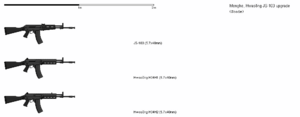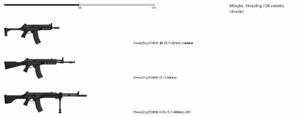Hwasŏng H34
| H34 | |
|---|---|
 The base variants H34H1 and H34H2, with a JS-103 for comparison. | |
| Type | Assault rifle |
| Place of origin | |
| Service history | |
| In service | 2018-present |
| Production history | |
| Designer | Hwasŏng Arsenal 55 |
| Designed | 2014-2017 |
| Produced | 2017-present |
| Variants | see below |
| Specifications (H34G2 JS) | |
| Weight | 3.3 kg without magazine 3.7 kg with 30rnd magazine |
| Length | 945 mm (stock extended) 698mm (stock folded) |
| Barrel length | 400 mm |
| Cartridge | 5.7x40mm |
| Action | Gas operated, rotating bolt |
| Rate of fire | 650 rpm |
| Muzzle velocity | 900 m/s |
| Effective firing range | 500 m |
| Maximum firing range | 800 m (area target) |
| Feed system | 10, 30, or 60-round detachable box magazine or 75 or 100-round drum magazine |
| Sights | Adjustable aperture iron sights top rail for attaching optics |
Hwasŏng H34 is the prototype designation given to a JS-103 conversion kit produced by Hwasŏng Arsenal 55. It consists of an all-new extruded aluminium upper receiver and trunnion, with optional mounting rails for a polymer lower handguard. The lower receiver, barrel, bolt group, and gas piston are all carried forward from the JS-103, and the JS-103's folding polymer buttstock can also be mounted. The "N" variant also adds a non-reciprocating, ambidextrous charging handle forward on the upper receiver.
Development
The H34 arose as an independent design project within Hwasŏng, before the official MoND requirement that led to the H35. It arose in response to many of the same issues. Due to its AN-style construction, the JS-103 could not mount optics directly on top of the upper receiver, only via a dovetail rail on the left side of the lower receiver. Though the lack of optics options was acceptable for rank-and-file conscripts, special forces and elite units increasingly stressed the need for better modularity, and the Menghean Army's long-term upgrading plan increasingly touted optics as a standard option.
Rather than design an all-new firearm, Hwasŏng initially opted for a conversion kit which would re-use as many parts from the original JS-103 as possible. With some 3,000,000 JS-103s and derivatives produced and the arms factories still running, the designers viewed parts commonality as a way to limit costs and waste and allow easy replacement of old weapons. On the other hand, the conversion approach limited the number of improvements that could be made, in particular to the long-stroke action and lower receiver.
Two main assault rifle variants were made, with different changes. The simpler modification, designated H34H1, retains the right-side charging handle of the original JS-103, cutting a recess in the bottom of the upper receiver to leave it space to travel. On the more thorough H34H2, the original charging handle is removed and its base filed over, with no gap behind the ejection port. Instead, a non-reciprocating, ambidextrous-reversible charging handle is mounted on the upper receiver and linked to the bolt by a spring-retained rod.
The H34 was first unveiled to the general public in 2017, and uniquely for a Menghean firearm it proceeded directly to the civilian market in a semi-automatic conversion. The lack of a standard Type designation indicates that it was not accepted for service by the Menghean Armed Forces, and subsequent press releases on the development of a JS-103 replacement suggest that the MoND was interested in moving directly to a completely new firearm. Hwasŏng itself made a similar turn, shifting its main rifle design team to the H35 prototype.
Design
Configuration
Fully assembled, the Hwasŏng H34 has some resemblance to the JS-103, but it differs in several important respects. The upper receiver is machined from a single piece of extruded aluminium, offering greater strength than the original stamped steel for a reduction in weight. More importantly, the barrel and gas tube are mounted directly to the upper receiver by means of a new trunnion and bolt travel rail, which also hold the barrel in place more firmly than the original JS-103 ones. Consequently, any optics mounted on the upper receiver will remain firmly aligned with the barrel even if the weapon is field-stripped. The fact that the MARS rail on top of the receiver is machined from the same extruded blank rather than welded on gives additional precision.
To disassemble the weapon, the operator first pushes through a captive pin running across the back of the upper receiver, allowing the bottom receiver to pivot down on its other captive pin at the forward end. This pin can also be removed to fully disassemble the weapon. The return spring, bolt group, and charging handle connection can then be removed from the back of the upper receiver. A separate pin forward of the link between the trunnion and lower receiver connects the slide-on lower handguard, which is carried forward to the H35.
Sights
Of the original iron sights, only the front sight is retained, as it sits directly on the JS-103's gas block. This is a simple post enclosed in a 3/4 protective circle. The rear sight is entirely new, consisting of an adjustable aperture near the end of the receiver. Compared with the JS-103's Patridge-type tangent rear sight, this offers much better parallax reduction for more precise aiming. The rail covering the rest of the upper receiver can be used to mount any MARS-compatible optics, without the use of a side rail converter.
Accessories
On the "N" variant of the rifle, the original right-side charging handle is removed and a new non-reciprocating charging handle is mounted above the gas tube. The charging handle itself can be switched to either the left or right side, and can be reversed to angle upward or downward, depending on user preference. An L-shaped tab of stamped metal is also welded to the receiver just behind the revised ejection port, to deflect any spent cartridges thrown to the rear and thus keep them clear of the user's face when firing left-handed. This approach requires a larger number of separate parts, but is said to improve the weapon's reliability by removing the charging handle movement slot behind the bolt, which allowed dirt and sand to enter the action and potentially interfere with the trigger group. Both of these solutions were carried forward to the H35.
Because the buttstock mounts to the rear of the lower receiver, the H34 can use the same buttstock options as the JS-103. Generally the solid black polymer buttstock of the production JS-103 is retained, to further reduce waste in the repurposing of old arms, but modern buttstocks with adjustable length of pull and raised cheek platforms are also available. The standard-issue lower handguard is made from polymer and has four MASS slots on the left, right, and bottom for mounting accessories.
To maintain the barrel in a floating configuration, the forward attaching ring for the shoulder strap was moved from the gas block to the front end of the upper receiver. As on the JS-103, the rear attaching ring is located on the left side of the lower receiver behind the dovetail rail.
Ergonomics
In a final minor change for comfort, the original safety/fire selector dial, which was located on the left-hand side of the lower receiver only, was replaced by a dual-sided dial for ambidextrous use. Functionally, the mechanism is completely identical, with safe, semi-auto, and fully automatic settings. It is still slightly further back than most users find comfortable.
Variants
In addition to its H1 and H2 variants, which differ in the placement of the charging handle, the H34 also comes in assault rifle, carbine, and LMG variants. All of them come in H34H1 and H34H2 variants. Like the variants of the JS-103, these weapons share the same parts inside the receiver, but use different barrels and generally different buttstocks. In contrast to the H35, the barrels on all variants are bolted directly to the trunnion, and it is not possible to convert the H34 from one configuration to another without the use of special armory tooling.
The H34 JjS (jjalbŭn-sochong, short rifle) uses the 240mm barrel from the JjS-104 carbine. It is also typically rebuilt with the JjS-104's skeleton buttstock, though it can use any JS-103-family buttstock. Because the front sight is much closer to the breech on the carbine, the H34 JjS must be built with a cut-down version of the standard H34 upper receiver, and is issued with a shorter polymer handguard.
The H34 GCh (gigwanchong, machine gun) uses the 520mm barrel and gas piston assembly from the CGh-105 light machine gun. To improve accuracy, the bipod is removed from the barrel and replaced with a modular custom bipod on the lower handguard, which is longer than its counterpart on the H34 base version. Because the H34's main improvement is its ability to mount optics, most production within Menghe has favored the H34 GCh/PCh, with the H34 GCh mainly offered for export.
The H34 GCh/PCh (gigwanchong mit pyŏnghyŏngchu, machine gun with counterweight) uses the barrel and gas piston assembly from the CGh-105 PCh. This differs from the H34 GCh in mounting a balanced recoil or BARS system, which uses a moving counterweight forward of the gas port to partially cancel out the rearward movement of the bolt. Like the H34 GCh, it uses the same upper receiver parts as the basic H34 with a lengthened handguard.
All of the above variants are available for export in 5.45×39mm and 7.62×39mm ammunition.
Service
As of October 2019, the Menghean Ministry of National Defense has not formally adopted the H34, giving it neither an all-new Type designation nor a JS-103 variant designation. Nevertheless, some special forces units have used their discretionary budgets to purchase small numbers of conversions under the original H34 manufacturer's designation. Menghean Internal Security Troops on training exercises, identified as both SDY and TDJB units, were photographed with what appeared to be H34s in 2018, though other sources suggest that these same units are currently re-arming with H35s.

